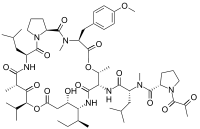Plitidepsin
Plitidepsin (also known as dehydrodidemnin B, marketed by PharmaMar, S.A. under the trade name Aplidin) is a chemical compound extracted from the ascidian Aplidium albicans.[1] It is currently undergoing clinical trial testing. It is a member of the class of compounds known as didemnins.
 | |
| Names | |
|---|---|
| IUPAC name
(S)-N-((R)-1-(((3S,6R,7S,10R,11S,15S,17S,20S,25aS)-10-((S)-sec-butyl)-11-hydroxy-20-isobutyl-15-isopropyl-3-(4-methoxybenzyl)-2,6,17-trimethyl-1,4,8,13,16,18,21-heptaoxodocosahydro-1H-pyrrolo[2,1-f][1,15,4,7,10,20]dioxatetraazacyclotricosin-7-yl)amino)-4-methyl-1-oxopentan-2-yl)-N-methyl-1-(2-oxopropanoyl)pyrrolidine-2-carboxamide | |
| Other names
Aplidine; Dehydrodidemnin B; Aplidin; N-[1-(1,2-Dioxopropyl)-L-prolyl]didemnin A | |
| Identifiers | |
3D model (JSmol) |
|
| ChEBI | |
| ChemSpider | |
| KEGG | |
| UNII | |
CompTox Dashboard (EPA) |
|
| |
| |
| Properties | |
| C57H87N7O15 | |
| Molar mass | 1110.357 g·mol−1 |
| Pharmacology | |
| L01XX57 (WHO) | |
Except where otherwise noted, data are given for materials in their standard state (at 25 °C [77 °F], 100 kPa). | |
| Infobox references | |
Chemical structure
Plitidepsin is a cyclic depsipeptide, meaning it is a cyclic peptide in which there is one or more ester bond in place of one or more of a peptide bond. Its chemical structure is very close to that of didemnin B, the only difference being that the lactate residue in didemnin B is present in the oxidized pyruvate version.
Pharmacological activity
Like all didemnin compounds, plitidepsin exhibits antitumor, antiviral and immunosuppressive activities. It shows promise in shrinking tumors in pancreatic, stomach, bladder, and prostate cancers.[2][3]
Marketing authorisation status
European Union
In July 2003, plitidepsin was granted orphan drug status by the European Medicines Agency for treating acute lymphoblastic leukemia.[4] On 14 December 2017, EMA´s Committee for Medicinal Products for Human Use adopted a negative opinion, recommending the refusal of the marketing authorisation for the treatment of multiple myeloma. PharmaMar requested a re-examination of the initial opinion. After a re-examination of the opinion, the refusal of the marketing authorisation was confirmed on 22 March 2018. The CHMP was of the opinion that the benefits of Aplidin did not outweigh its risks. Improvement in overall survival was not sufficiently demonstrated, and severe side effects were reported more frequently with the combination of Aplidin and dexamethasone than with dexamethasone alone.[5]
Australia
In Australia plitidepsin was approved in December 2018, in combination with dexamethasone, for the treatment of patients with relapsed and refractory multiple myeloma who have received at least three prior treatment regimens, including both a proteasome inhibitor and an immunomodulator. It may be used after two prior lines of therapy if refractory and/or intolerant to both a proteasome inhibitor and an immunomodulator.[6]
Clinical trials
As of 2007, it was undergoing multicenter phase II clinical trials.[3]
In 2016, early results in a small phase I trial for multiple myeloma were announced.[7]
References
- Cragg, G.M. & Newman, D.J. (2004). "Marine natural products and related compounds in clinical and advanced preclinical trials". Journal of Natural Products. 67 (8): 1216–1238. doi:10.1021/np040031y. PMID 15332835.
- Garrison, Tom. Oceanography: An Invitation to Marine Science 4th ed. United States: Brooks/Cole. 2002. 98.
- Adrio, J.; et al. (2007). "Total Synthesis and Biological Evaluation of Tamandarin B Analogues". Journal of Organic Chemistry. 72 (14): 5129–5138. doi:10.1021/jo070412r.
- Public Summary of Positive Opinion for Orphan Designation of Aplidine for the Treatment of Acute Lymphoblastic Leukaemia
- EMA - Aplidin
- Australian Public Assessment Report: Plitidepsin
- ASCO: Plitidepsin Shows Activity in Multiple Myeloma. June 2016